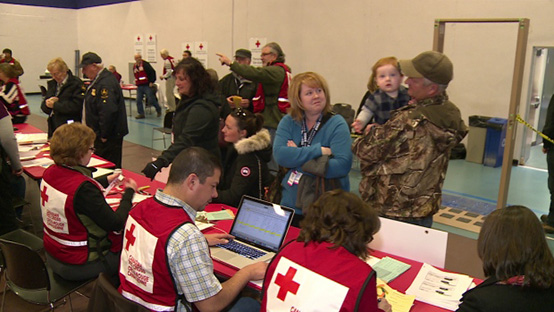Safety and control area series – Emergency management and fire protection
Safety and control areas
The Canadian Nuclear Safety Commission (CNSC) is responsible for evaluating how well licensees meet regulatory requirements and expectations. CNSC staff consider the performance of programs in 14 different safety and control areas (SCAs). For the next several months, we will be publishing a series detailing each SCA and its significance for the CNSC and its licensees. This feature article will focus on the emergency management and fire protection SCA. For a general overview on all SCAs and their functional areas, visit the CNSC’s safety and control areas Web page.
What is emergency management and fire protection?
As part of their licensing basis, all licensees must be prepared to respond to emergency situations. Under the emergency management and fire protection SCA, certain licensees are required to have CNSC-accepted emergency preparedness plans, programs and procedures in place to respond to emergencies and non-routine situations.
The CNSC requires Class I and uranium mines and mills licensees to have programs for emergency management and fire protection.
| Emergency management | Fire protection |
|---|---|
Licensees are required to have and maintain a nuclear emergency management program that allows them to prepare for, respond to and recover from the effects of accidental radiological/nuclear and/or hazardous substance releases from emergencies. The facility must be able to activate its emergency response organization to ensure that the response has a clear command and control structure. At the same time, the facility must stay flexible and adaptable to keep pace with the emergency as it evolves, in order to ensure the safety of the workers, the public and the environment. Licensees are required to continually maintain and enhance their nuclear emergency management programs. This is accomplished through training, drills and exercises, and by incorporating lessons learned from real events and previous exercises. | Licensees require a comprehensive fire protection program that is a set of planned, coordinated activities by various contributing disciplines and organizations intended to ensure adequate protection against fires. Fire protection provisions apply to all work related to the design, construction, operation and maintenance of a nuclear facility, including systems, structures and components that directly support the plant and protected areas. In addition, some licensees have an onsite fire response capability in the form of an industrial fire brigade or emergency response team, which routinely participates in training and drills to provide structural firefighting and other response capabilities at the licensed location. |
Emergency preparedness: Who does what?
While emergency preparedness and fire protection rely heavily on the preparation of licensees, they also rely on readiness across multiple levels of government – international, federal, provincial and municipal.
The CNSC’s Emergency Management Programs Division is in continuous contact with these levels of government to see that relationships, policies, processes, regulatory tools and training are all maintained to ensure an effective response should an emergency occur.
The prevention of nuclear emergencies at every Canadian facility is the responsibility of licensees. This encompasses all onsite emergency responses to ensure that prevention, mitigation, response and recovery capabilities are maintained and continually enhanced within their facility’s buildings and property.

Provincial and territorial governments bear the primary responsibility for protecting public health and safety, infrastructure and the environment within their borders. Emergency management organizations are responsible for all offsite emergency responses in any affected areas surrounding the licensed facility.
The Government of Canada:
- regulates the peaceful use of nuclear energy in Canada
- manages nuclear liability
- supports provincial responses to nuclear emergencies within their boundaries
- is responsible for liaisons with the international community and diplomatic missions in Canada
- assists Canadians abroad
- coordinates Canada’s response to nuclear emergencies that occur in foreign countries and have an impact on Canada
Practice makes perfect
The CNSC participates in full-scale emergency exercises with licensees and other levels of government to ensure that the CNSC Emergency Operations Centre and its Nuclear Emergency Organization can effectively respond to an emergency. These exercises test the ability of CNSC staff to provide regulatory oversight of a licensee in an emergency situation, provide assessment and prognosis of the facility in distress, and test the linkages between the various layers of other government departments. This ensures that the CNSC fulfills its mandate and international obligations under the Convention on Early Notification of a Nuclear Accident
CNSC staff also evaluate their internal response to the exercises, and incorporate the lessons learned and opportunities for improvement into their own internal plans and procedures to ensure that continuous improvement is maintained.
Striving for continuous improvement
The CNSC is always striving to become the world’s best nuclear regulator by constantly learning from best international practices while continually strengthening its own policies and procedures. Following a large-scale event like the Fukushima Daiichi disaster, the global emergency management community is paying more attention to:
- clarifying the licensee’s onsite and offsite responsibilities
- dealing with affected residents and businesses in the aftermath of an emergency
- evaluating emergency plans for organizations with offsite responsibilities
- enhancing public awareness, communications and outreach products
- enhancing public alerting, communications, and outreach products to provide a better understanding of health impacts
- determining what to do in the unlikely event of a nuclear emergency
- ensuring that licensees are fully self-sufficient for at least the first 72 hours after an accident in the event of an extended emergency situation.
Stay tuned for more from our SCA series!